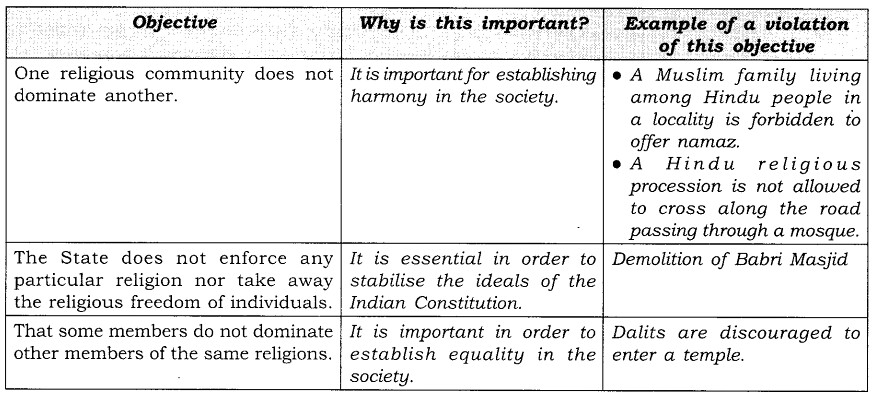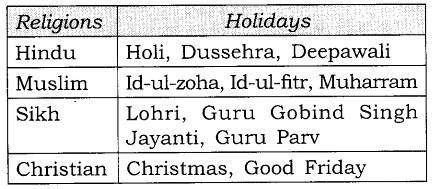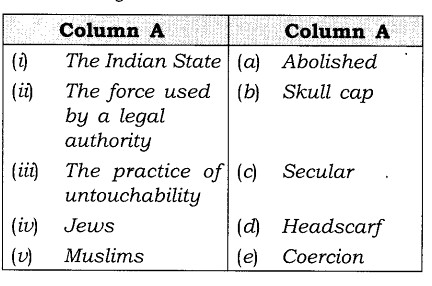Civics Notes VIII
Ch:1 The Indian Constitution
Question 1.
Why does a democratic country need a Constitution?
Solution:
A democratic country needs a constitution because
- In a democracy people choose their representatives and the leaders might misuse their powers. Constitution provides safeguards against this.
- In a democracy, the constitution ensures that the dominant group does not use power against less powerful groups.
- The constitution guarantees fundamental rights to the citizens for their social, economic, and political welfare.
Question 2.
What is the difference in who exercises Executive Power in the 1990 and Interim Constitutions of Nepal? Keeping this in mind, why do you think Nepal needs a new Constitution today?
Solution:
In the 1990 Nepal constitution, the Executive powers of the Kingdom were entirely in the hands of the King. According to the Interim constitution drafted in 2007, the executive powers of Nepal are in the hands of the council of ministers headed by the Prime Minister.
There was a dire need for a new constitution as the ideals of the people had changed as the country had moved from a monarchy to a democracy. The old constitution was drafted when the country was under the rule of the king. The people of Nepal fought for a democratic government for many years. So the old constitution does not reflect the ideals of the people. The new constitution will change the rules of the old constitution in order to bring in a new society with new ideas.
Question 3.
What would happen if there were no restrictions on the power of elected representatives?
Solution:
If there were no restrictions on the power of elected representatives then:
- These leaders (representatives) might misuse their authority.
- This misuse of authority can result in gross injustice and mismanagement.
Question 4
In each of the following situations, identify the minority. Write one reason why you think it is important to respect the views of the minority in each of these situations.
(a) In a school with 30 teachers, 20 of them are male.
(b) In a city, 5 percent of the population are Buddhists.
(c) In a factory mess for all employees, 80 percent are vegetarians.
(d) In a class of 50 students, 40 belong to more well-off families.
Solution:
(a) 10 female teachers are in minority.
It is important to respect the views of female teachers so that male teachers do not use their power against them.
(b) 5 percent of Buddhists are in minority.
It is important to respect the views of Buddhists so that they will not be dominated by the community in the majority.
(c) 20 percent of non-vegetarian employees are in minority.
Their views should be respected as eating non-vegetarian food is their personal choice.
(d) 10 students belong to poor families and are in minority. Scholarships, special classes, and other welfare schemes like book bank, free supply of books, stationary and free uniform are to be planned to keep in view their requirements.
Question 5
Listed below are the key features of the Indian Constitution. Write two sentences, in your own words, on why you think this feature is an important key feature of
- Federalism
- Separation of Powers
- Fundamental Rights
- Parliamentary Form of Government
Solution:
- Federalism:
means more than one level of government in the country. India has a 3 tier government. India needs a 3 tier government because of the diverse religious and cultural composition of its citizens. A government in the centre alone could not be effective for everyone. - Separation of Powers:
In order to prevent the misuse of power by the elected representative the constitution advocate Separation of powers. Each branch of the government has its powers fixed by the Constitution. The Constitution ensures that a balance of power is maintained between the Legislature Executive and the Judiciary. - Fundamental Rights:
Fundamental Rights guarantees the rights of individuals against the State as well as against other individuals. It protects minority communities and guarantees rights against the majority. - Parliamentary Form of Government:
In a Parliamentary form of government, the constitution guarantees universal adult franchise for all citizens. That is, all adults have a right to vote, irrespective of whether they are poor or rich, educated or uneducated, a Hindu, Muslim or a Christian. The idea of a universal adult franchise is based on equality.
Ch: 2 Understanding Secularism
Question 1.
Will the government intervene if some religious group says that their religion allows them to practice infanticide? Give reasons for your answer.
Solution:
Yes, the government will and should intervene because this practice is against the right to freedom to live. Moreover, it is a crime to kill or practice infanticide.
Let’s Recall
Question 1.
List the different types of religious practices that you find in your neighbourhood. This could be different forms of prayer, worship of different gods, sacred sites, different kinds of religious music and singing, etc. Does this indicate freedom of religious practice?
Answer:
Different types of religious practice:
(i) Jagran
(ii) Kirtan
(iii) Namaj
(iv) Mass
(v) Havan
Yes, this indicates freedom of religious practice.
Question 2.
Will the government intervene if some religious group says that their religion allows them to practice infanticide? Give reasons for your answer.
Answer:
The government will surely intervene if some religious group says that their religion allows them to practice infanticide. Needless to say that the practice of infanticide is a crime. Under this practice the life of a newly-born child is killed. The law does not allow anyone to kill a life.
Question 3.
Complete the following table:
Answer:
Question 4.
Look up the annual calendar of the holidays of your school. How many of them pertain to different’religions? What does this indicate?
Answer:
Holidays in a school calendar for different religions:
Question 5.
Find out some examples of different views within the same religion.
Answer:
Different views are followed even within the same religion. As for example, only in the Hindu religion, we have hundreds of deities worshipped by different groups of people. Similarly, in the Muslim community, there are Shiyas and Shunnis. In Jainas, there are Shwetambar and Digambar sects. In Buddha Dharma, there are Hinayaans and Mahayaans.
Question 6.
The Indian State both keeps away from religion as well as intervenes in religion. This idea can be quite confusing. Discuss this once again in class using examples from the chapter as well as those that you might have come up with.
Answer:
India is a land of complex ideas. It is difficult to understand what it really wants. There are many ideals in the Constitution but practices are quite different from them. In many cases we see laws explain a concept in a different way. But people interpret it differently. Law itself in some cases acts differently. As for example, in secular state law has nothing to say in any of the practices of the religion but when the dominance of upper castes in religion was brought to question the law took favour of the lower castes. This interference of the State creates confusion.
Question 7.
This poster highlights the need for ‘Peace’. It says, “Peace is a never-ending process….. It cannot ignore our differences or overlook our common interests.” Write in your own words what you think the above sentences are trying to convey? How does it relate to the need for religious tolerance?
This chapter had three drawings on religious tolerance made by students of your age. Design your own poster on religious tolerance for your peers.
Answer:
- Peace is a never-ending process. It is the need of today.
- Peace respects our common interest and removes or minimize our difference.
- Peace helps us to live together in harmony.
I. Multiple Choice Questions
Choose the correct option:
(i) Which one is a correct statement with regard to Saudi Arabia?
(a) Non-Muslims can gather in a public place for prayer.
(b) They cannot build a temple, church, etc.
(c) They can live in their own way.
(d) None of the above
(ii) The most important aspect of secularism is its …………
(a) separation of religion from State power
(b) separation of politics from religion
(c) separation of one community from another
(d) mixing of religion with State power
(iii) The government cannot force Sikhs to wear a helmet while driving two-wheelers because ………..
(a) Sikhs are very powerful
(b) they do not obey government rules
(c) they look handsome in pagri
d) wearing a pagri is a very important part of Sikh religion
(iv) In American secularism, there is a …………
(a) the strict separation between religion and the State
(b) the loose separation between religion and the State
(c) the strict mingling of religion with the State
(d) the strict rule that contracts all religions
Answer:
(i) (b), (ii) (a), (iii) (d), (iv) (a).
II. Fill in the Blanks.
Fill in the blanks with appropriate words to complete each sentence.
- The intervention of the State can also be in the form of ………….
- In the United States of America, most children in government schools have to begin their school day reciting the
- ‘Pledge of ……………….
- The most important aspect of secularism is its separation of religion from …………. power.
- Government schools don’t celebrate any ………….. festivals on the school premises.
- The Indian State is not ruled by a ……………….. group and nor does it …………… any one religion.
Answer:
- support
- Allegiance
- state
- religious
- religious, support
III. True/False
State whether each of the following statements is True or False.
- In Indian secularism, the State is not strictly separate from religion.
- Wearing a pagri is central to a Sikh’s religious practice.
- Government schools can promote any one religion.
- The Indian Constitution does not grant religious communities to set up their own schools and colleges.
- In Indian secularism, the State cannot intervene in religion.
Answer:
- True
- True
- False
- False
- False
IV. Matching Skills
Match the items given in Column A correctly with those given in Column B.
Answer:
(i) (d), (ii) (e), (iii) (a), (iv) (b), (v) (c).
Class 8 Social Chapter 2 Understanding Secularism Very Short Answer Type Questions
Question 1.
What examples does history provide us on the grounds of religion?
Answer:
History provides us with several examples of discrimination, exclusion, and persecution on the grounds of religion.
Question 2.
What happened in the Jewish state of Israel?
Answer:
Muslim and Christian minorities were treated badly in the Jewish state of Israel.
Question 3.
How are non-Muslims treated in Saudi Arabia?
Answer:
In Saudi Arabia, non-Muslims are not allowed to build a temple, church etc. They also cannot gather in a public place for prayers.
Question 4.
What does the term ‘secularism’ refer to?
Answer:
The term ‘secularism’ refers to the separation of the power of religion from the power of the State.
Question 5.
What do you mean by the freedom to interpret’?
Answer:
‘Freedom to interpret’ means an individual’s liberty to develop his own understanding and meaning of the religion that one practices.
Question 6.
Why cannot government schools celebrate religious festivals?
Answer:
Government schools cannot celebrate religious festivals because it will be a violation of the government’s policy of treating all religions equally.
Question 7.
Why is Paramjit allowed to drive in pagri?
Answer:
Paramjit is a Sikh youth and for him wearing a pagri is a very important part of his religion.
Question 8.
How is Indian secularism different from that of American secularism?
Answer:
Unlike Indian secularism, there is a strict separation between religion and the State in American secularism.
Question 9.
What is meant by ‘principled distance’?
Answer:
This means that any interference in religion by the State has to be based on the ideals laid out in the Constitution.
Class 8 Social Chapter 2 Understanding Secularism Short Answer Type Questions
Question 1.
Why is it important to separate religion from the State? Explain with examples.
Answer:
There are two main reasons why the separation of religion from the State is important:
The first is to prevent the domination of one religion over another. Example: Almost all countries of the world will have more than one religious group living in them. Within these religious groups, there will most likely be one group that is in a majority. If this majority religious group has access to State power, then it could quite easily use this power and financial resources to discriminate against and persecute persons of other religions. This would violate Fundamental Rights.
The second is to protect the freedom of individuals to exit from their religion, embrace another religion or have the freedom to interpret religious teachings differently. Example: We can give an example of untouchability in Hindu religious practice. If state power were in the hands of those Hindus who support untouchability, then it would be a difficult task for anyone to abolish this practice.
Question 2.
What are the three objectives of a secular State?
Answer:
The three objectives of a secular State are:
- One religious community does not dominate another.
- Some members do not dominate other members of the same religious community.
- The State does not enforce any particular religion nor does it take away the religious freedom of individuals.
Question 3.
Explain with an example that in Indian secularism the State can intervene in religious affairs.
Answer:
An important aspect of India’s secularism is that the State can intervene in religious affairs. We can prove this fact with an example of untouchability. It was a practice in which the members of the same religion, i.e. upper-caste Hindus, dominated other members, i.e. lower caste people, within it. In order to prevent this religion-based exclusion and discrimination of lower castes, the Indian Constitution banned untouchability. In this instance, the State intervened in religion in order to end a social practice that it believed discriminated against and excluded and that violated the Fundamental Rights of Lower castes.
Question 4.
What is secularism?
Answer:
The Indian Constitution contains Fundamental Rights. These rights are very important because they protect us against State power as well as against the tyranny of the majority. The Indian Constitution allows individuals the freedom to live by their religious beliefs and practices as they interpret these. Thus, our Constitution gives religious freedom to all and to maintain it India adopted a strategy of separating the power of religion and the power of the State. Secularism is, in fact, the separation of religion from the State.
Class 8 Social Chapter 2 Understanding Secularism Long Answer Type Questions
Question 1.
In what different ways does the Indian State work to prevent religious domination?
Answer:
Indian secularism works in various ways to prevent religious domination:
(a) It uses a strategy of distancing itself from religion. The Indian State is not ruled by a religious group. It also does not support any one religion. In our country, government places like law courts, police stations, government schools, and offices are not supposed to demonstrate or promote any one religion.
(b) The second way in which Indian secularism works to prevent the domination of religion is through a strategy of non-interference. This means that in order to respect the sentiments of all religions and not interfere with religious practices, the State makes certain exceptions for particular religious communities. Just take the example of the Sikh community. For Sikhs, wearing a pagri is a very important part of their religion. The government cannot force them to wear a helmet while driving a two-wheeler.
(c) The third way in which Indian secularism works to prevent the domination of religion is through a strategy of intervention. Untouchability presents a good example where members of the same religion, e.upper caste Hindus, dominate other members, lower castes within it. In order to prevent this religion-based discrimination of lower castes, our Constitution banned untouchability. Here, the State intervened in religion in order to uproot a social practice that it believed discriminated against and excluded, and that violated the Fundamental Rights of the people belonging to the lower caste.
Comments
Post a Comment